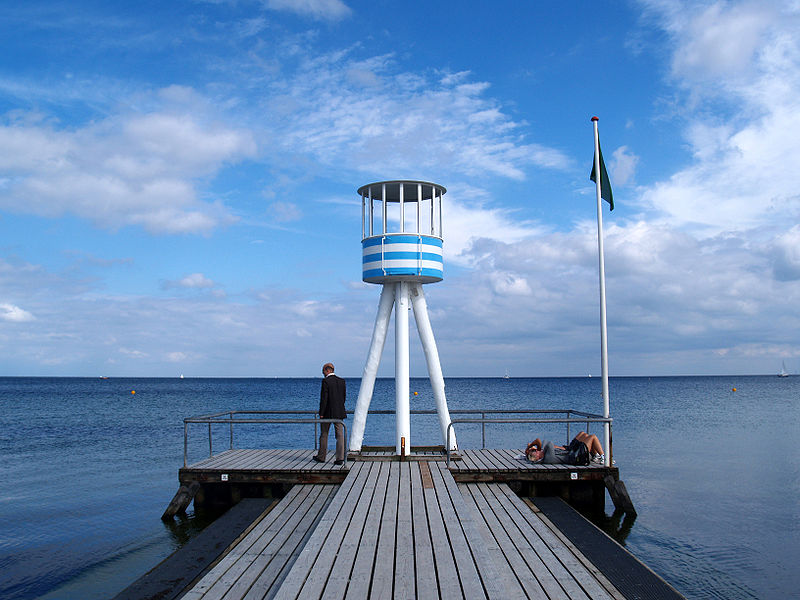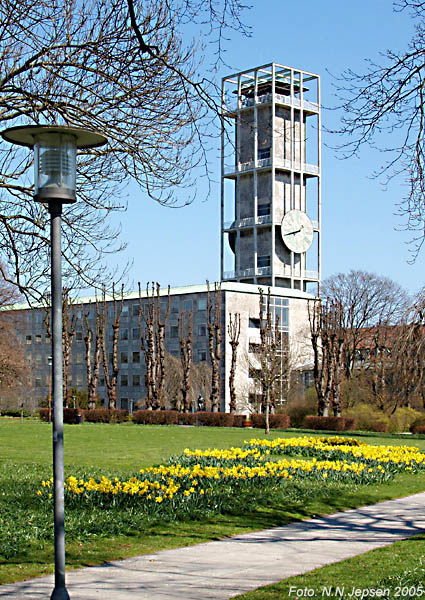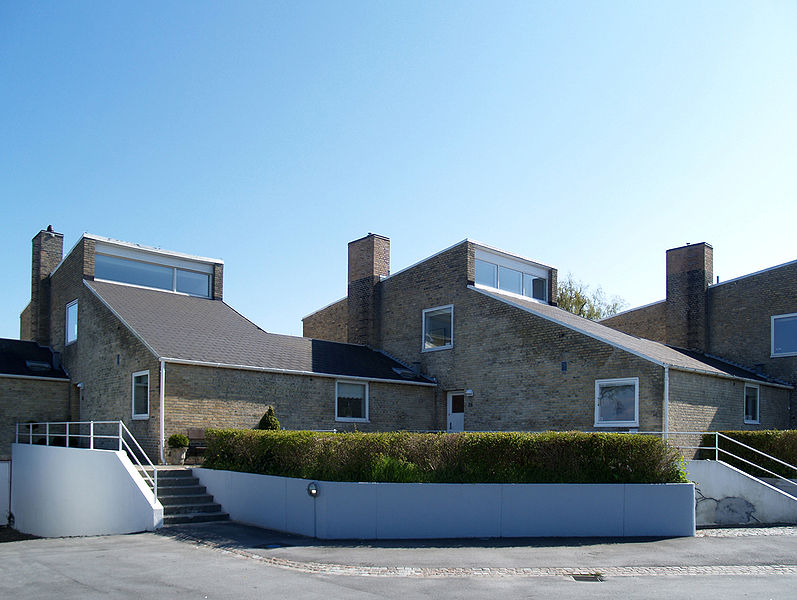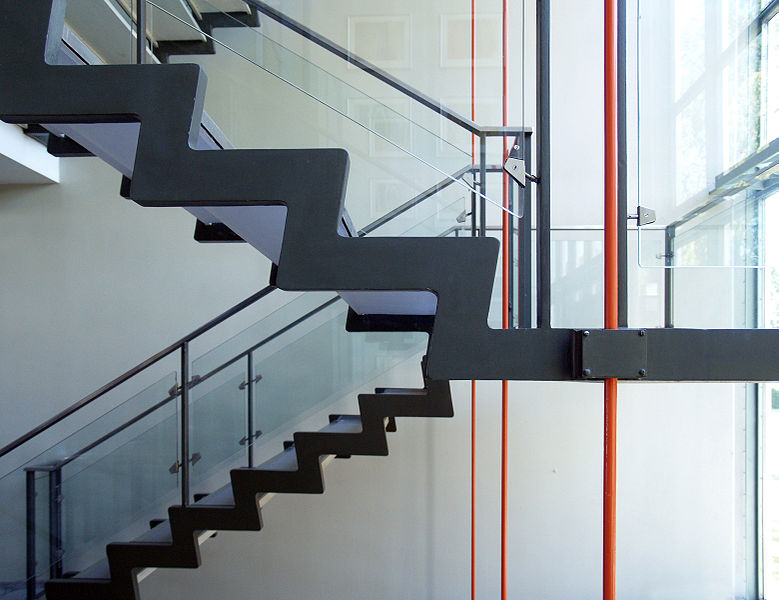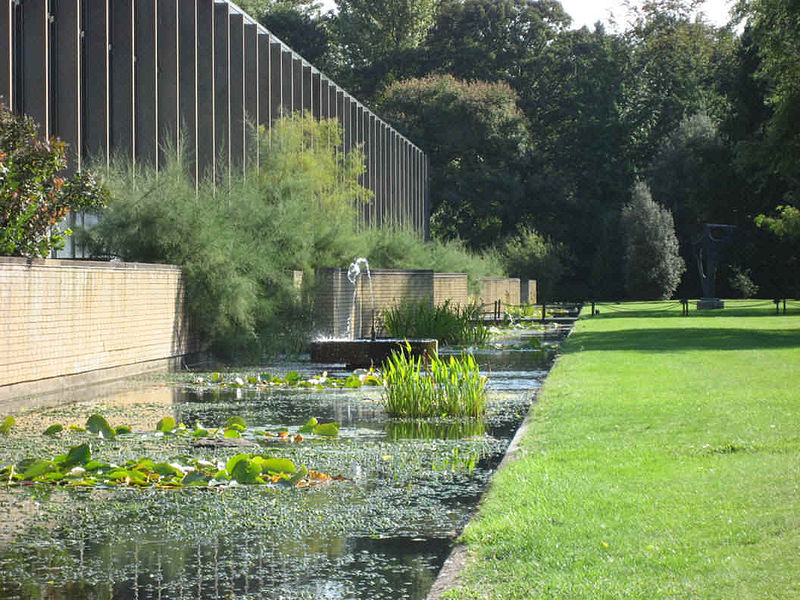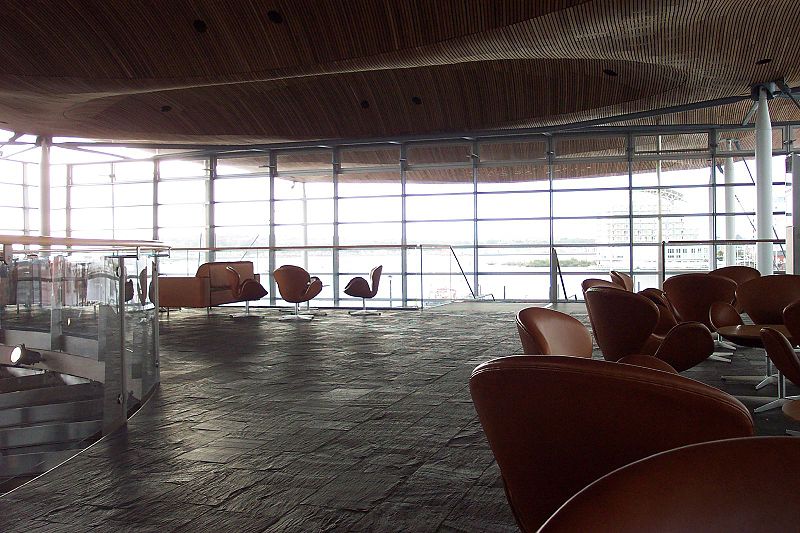<Back to Index>
- Physicist Leó Szilárd, 1898
- Architect and Designer Arne Emil Jacobsen, 1902
- King of Egypt and the Sudan Farouk I, 1920
PAGE SPONSOR
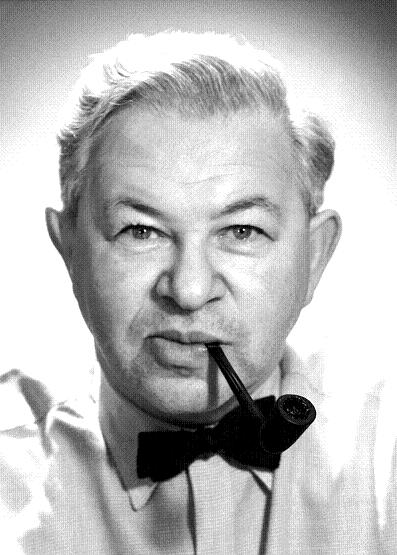
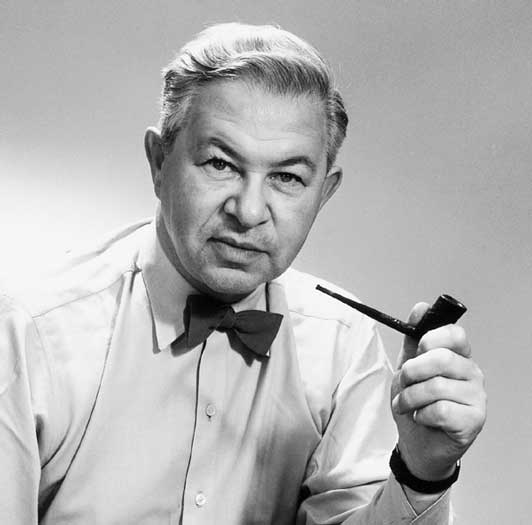
Arne Emil Jacobsen, usually known as Arne Jacobsen, (11 February 1902 – 24 March 1971) was one of Denmark's most successful architects and designers. In particular, he is remembered for developing the 'Danish Modern' style and for contributing so much to architectural functionalism. In addition to his architectural work, he was one of the most important contributors to Danish design, especially as a result of the worldwide success he enjoyed with simple but effective chair designs.
Arne Jacobsen was born on 11 February 1902 in Copenhagen to upper middle class Jewish parents. He first hoped to become a painter but was dissuaded by his father who encouraged him to opt instead for the more secure domain of architecture. After a spell as an apprentice mason, Jacobsen was admitted to the Architecture School at the Royal Danish Academy of Fine Arts where from 1924 to 1927 he studied under Kay Fisker and Kaj Gottlob, both leading architects and designers.
Still a student, in 1925 Jacobsen participated in the Paris Art Deco fair, Exposition Internationale des Arts Décoratifs et Industriels Modernes, where he won a silver medal for a chair design. On that trip, he was struck by the pioneering aesthetic of Le Corbusier's L'Esprit Nouveau pavilion. Before leaving the Academy, Jacobsen also travelled to Germany, where he became acquainted with the rationalist architecture of Mies van der Rohe and Walter Gropius. Their work influenced his early designs including his graduation project, an art gallery, which won him a gold medal. After completing architecture school, he first worked at city architect Poul Holsøe's architectural practice.
In 1929, in collaboration with Flemming Lassen, he won a Danish Architect's Association competition for designing the "House of the Future" which was built full scale at the subsequent exhibition in Copenhagen's Forum. It was a spiral-shaped, flat-roofed house in glass and concrete, incorporating a private garage, a boathouse and a helicopter pad.
Other striking features were windows that rolled down like car windows,
a conveyor tube for the mail and a kitchen stocked with ready-made meals. A Dodge Cabriolet Coupé was parked in the garage, there was a Chris Craft in the boathouse and an Autogyro on the roof. The name Jacobsen immediately became recognised as an ultra-modern architect. The
year after winning the "House of the Future" award, Arne Jacobsen set
up his own office. He designed the functionalist Rothenborg House,
which he planned in every detail, a characteristic of many of his later
works. Soon afterwards, he won a competition from Gentofte Municipality for the design of a seaside resort complex in Klampenborg on the Øresund coast
just north of Copenhagen. The various components of the resort became
his major public breakthrough in Denmark, further establishing him as a
leading national proponent of the International Modern Style. In 1932, the first item, the Bellevue Sea Bath, was completed. Jacobsen designed everything from the characteristic blue-striped lifeguard towers, kiosks and changing cabins to the tickets, season cards and even the uniforms of the employees. The focal point of the area was supposed to have been a lookout tower,
more than a hundred metres high with a revolving restaurant at the top
but it was abandoned after huge local protests. Still, it is reflected
in the overall arrangement of buildings in the area which all follow
lines that extend from their missing centre. In 1934, came the
Bellavista residential development, built in concrete, steel and glass,
with smooth surfaces and open floor planning, free of any excesses or
ornaments. Completing the white trilogy in 1937, the Bellevue Theatre featured a retractable roof allowing open-air performances. These
early works clearly show the influence of the White Cubist architecture
Jacobsen had encountered in Germany, particularly at the Weissenhof Estate in Stuttgart. The cluster of white buildings at Bellevue also includes the Skovshoved Filling Station. In their day, these projects were described as "The dream of the modern lifestyle". Despite considerable public opposition to his avant-garde style, Jacobsen went on to build Stelling House on Gammeltorv,
one of Copenhagen's most historic squares. Although the modernistic
style is rather restrained and was later seen as a model example of
building in a historic setting, it caused virulent protests in its day.
One newspaper wrote that Jacobsen ought to be "banned from architecture for life". When, together with Erik Møller, he won a competition for the design of Århus City Hall it
was with yet another controversial design. It was deemed too modern and
too anti-monumental. In the end Jacobsen had to add a tower as well as
marble cladding. Still, it is considered one of his most important buildings. It consists of three offset volumes. During World War II, scarcity of building materials made assignments difficult to obtain and in 1943, due to his Jewish background,
Arne Jacobsen had to abandon his office and go into exile to escape
planned deportation. He fled Denmark, rowing a small boat across Øresund to neighbouring Sweden where he would stay for the next two years. His
architectural work was limited to a summer house for two doctors. Instead he spent his time designing fabrics and wallpaper. When
the war ended in 1945, Jacobsen returned to Denmark and resumed his
architectural career. The country was in urgent need of both housing
and new public buildings but the primary need was for spartan buildings
which could be built without delay. After
some years Jacobsen got his career back on track and with projects such
as the Allehusene complex from 1952 and his Søholm terraced
houses from 1955 he embarked on a more experimental phase. He moved
into one of the Søholm houses himself and lived there until his
death. Rødovre Town Hall,
built from 1952 to 1956, shows how well Jacobsen combined the use of
different materials: sandstone, two types of glass, painted metalwork
and stainless steel. It is also noted for its central staircase,
suspended from the roof on orange-red steel rods. The sides are cut
from 5 cm steel plate, painted a dark grey; the steps, only a few
millimeters thick, are stainless steel with a rubber coating on the
upper side for better grip. The Munkegård School consists
of pavilions connected by glass corridors, arranged in a grid system
around small courtyards. It received considerable attention in
international school circles and contributed to his growing
international reputation.
With the SAS Royal Hotel, built from 1956 to 1960, Jacobsen was given the opportunity to design what has been called "the world's first designer hotel". He
designed everything from the building and its furniture and fittings to
the ashtrays sold in the souvenir shop and the airport buses. These
larger assignments started to attract attention and commissions from
abroad. Rødovre Town Hall secured him an invitation for his
first competition in Germany which was followed by a number of other
German projects. A delegation of Oxford dons visited the SAS Hotel and the Munkegård School in their search for an architect for St. Catherine's College. They were soon convinced he was the right choice for their important commission. Again
Jacobsen designed everything, including the garden, down to the choise
of fish species for the pond. The dining hall is notable for its
Cumberland slate floor. The original college buildings received a Grade I listing on 30 March 1993.
When Arne Jacobsen died unexpectedly in 1971, he had a number of large projects under way. These included a new town hall in Mainz, Germany, the Danish National Bank and the Royal Danish Embassy in London. These projects were completed by Dissing + Weitling, a firm set up by his former key employees Hans Dissing and Otto Weitling. Today,
Arne Jacobsen is remembered primarily for his furniture designs.
However, he believed he was first and foremost an architect. According to Scott Poole, a professor at Virginia Tech, Arne Jacobsen never used the word, notoriously disliking it. His way into product design came through his interest in Gesamtkunst and
most of his designs which later became famous in their own right were
created for architectural projects. Most of his furniture designs were
the result of a cooperation with the furniture manufacturer with which
he initiated a collaboration in 1934 while his lamps and light fixtures
were developed with Louis Poulsen.
In spite of his success with his chair at the Paris Exhibition in 1925,
it was during the 1950s that his interest in furniture design peaked. A major source of inspiration stemmed from the bent plywood designs of Charles and Ray Eames. He was also influenced by the Italian design historian Ernesto Rogers,
who had proclaimed that the design of every element was equally
important "from the spoon to the city" which harmonized well with his
own ideals. In 1951, he created the Ant chair for an extension of the Novo pharmaceutical factory and, in 1955, came the Seven Series. Both matched modern needs perfectly, being light, compact and easily stackable. Two other successful chair designs, the Egg and the Swan, were created for the SAS Royal Hotel in 1957. Other designs were made for Stelton,
a company founded by his foster son Peter Holmbl. These include the now
classic Cylinda Line stainless steel cocktail kit and tableware. According
to R. Craig Miller, author of "Design 1935 - 1965, What Modern was",
Jacobsen’s work "is an important and original contribution both to
modernism and to the specific place Denmark and the Scandinavian
countries have in the modern movement" and continues "One might in fact
argue that much of what the modern movement stands for, would have been
lost and simply forgotten if Scandinavian designers and architects like
Arne Jacobsen would not have added that humane element to it". Arne
Jacobsen is noted for his sense of proportion. Indeed, he himself saw
this as one of the main features of his work. In an interview he said;
"The proportion is exactly what makes the beautiful ancient Egyptian
temples [...] and if we look at some of the most admired buildings of
the Renaissance and Baroque, we notice that they were all
well-proportioned. Here is the basic thing".
